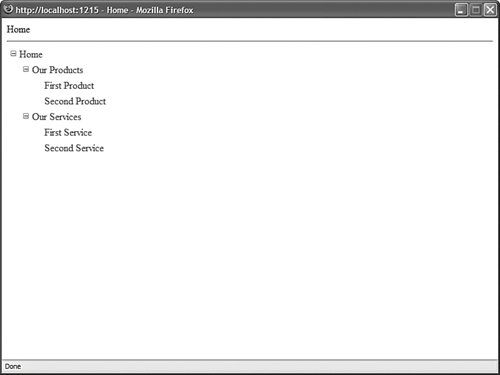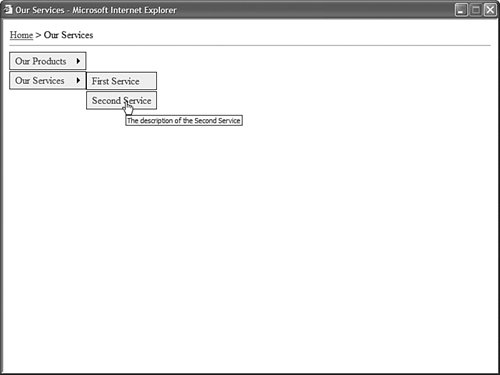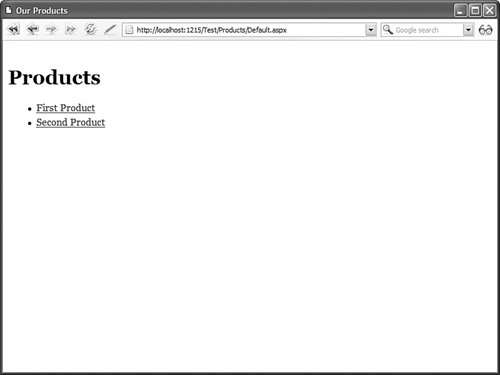Using the SiteMapDataSource Control
Using the SiteMapDataSource ControlThe SiteMapDataSource control enables you to represent a Site Map declaratively in a page. You can bind navigation controls such as the treeView and Menu controls to a SiteMapDataSource control. You also can bind other controls such as the GridView or DropDownList control to a SiteMapDataSource control. Imagine, for example, that your website contains the Web.sitemap file in Listing 18.1. Because the default SiteMapProvider is the XmlSiteMapProvider, the SiteMapDataSource control automatically represents the contents of this XML file. Note The code samples in this section are located in the SiteMaps application on the CD that accompanies this book. Listing 18.1. Web.sitemap
The Site Map file in Listing 18.1 represents a website with the following folder and page structure: Default.aspx Products FirstProduct.aspx SecondProduct.aspx Services FirstService.aspx SecondService.aspx The page in Listing 18.2 illustrates how you can represent a Site Map by binding a treeView control to the SiteMapDataSource control. Listing 18.2. Default.aspx
When you open the page in Listing 18.2, all the elements from the Web.sitemap file are displayed in the treeView control with the help of the SiteMapDataSource control (see Figure 18.1). Figure 18.1. Displaying a Site Map with a treeView control. Setting SiteMapDataSource PropertiesThe SiteMapDataSource control includes several valuable properties that you can set to modify the nodes that the control returns:
The most useful of these properties is the ShowStartingNode property. Normally, when you display a list of nodes with a Menu or TreeView control, you do not want to display the starting node (the link to the home page). The page in Listing 18.3 illustrates how you can bind a Menu control to a SiteMapDataSource that has the value False assigned to its ShowStartingNode property. Listing 18.3. Services/Default.aspx
When you open the page in Listing 18.3, only the second-level nodes and descendent nodes are displayed (see Figure 18.2). Figure 18.2. Hiding the starting node. The StartFromCurrentNode property is useful when you want to display a list of all nodes below the current node. For example, the page in Listing 18.4 is the Default.aspx page contained in the Products folder. It displays a list of all the product pages contained in the folder. Listing 18.4. Products/Default.aspx
The page in Listing 18.4 contains a BulletedList control bound to a SiteMapDataSource control. Because the SiteMapDataSource control has its StartFromCurrentNode property set to the value TRue and its ShowStartingNode property set to the value False, all immediate child nodes of the current node are displayed (see Figure 18.3). Figure 18.3. Displaying the contents of a folder. |
- Chapter II Information Search on the Internet: A Causal Model
- Chapter VI Web Site Quality and Usability in E-Commerce
- Chapter VIII Personalization Systems and Their Deployment as Web Site Interface Design Decisions
- Chapter X Converting Browsers to Buyers: Key Considerations in Designing Business-to-Consumer Web Sites
- Chapter XVII Internet Markets and E-Loyalty